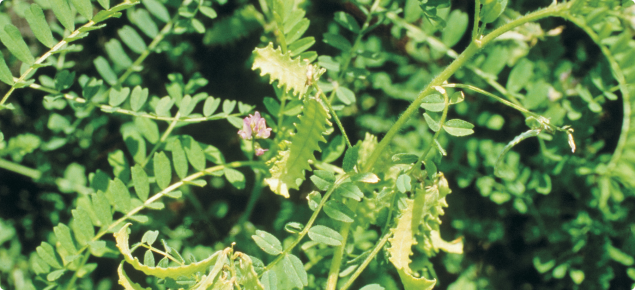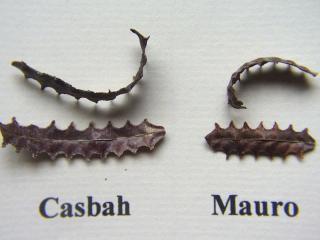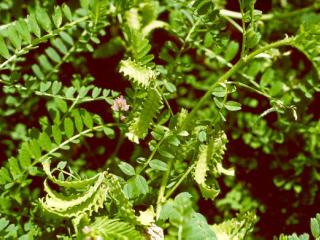Origin
Casbah was collected in Morocco, and Mauro in Sardinia. Casbah was selected by Dr A. Loi, Dr J. Howieson and Dr S. Carr and Mauro was selected by Dr Loi.
Description and area of use
Biserrula has a distinctive fern-like leaves, much like serradella. It is distinguishable by a notch in the top of each leaflet and its pale purple to blue flowers. Pods are flat with serrated edges.
Casbah is a mid-season cultivar, flowering in Perth about 100-105 days after emergence. It is suited to regions with 325-500 millimetres (mm) annual rainfall. Pods of Casbah contain about 20 seeds and individual seeds weigh about 1.2 milligrams (mg).
Mauro is a mid- to late-maturing cultivar, flowering in Perth about 115-120 days after emergence. It is suited to regions with 450-700mm annual rainfall. Pods of Mauro contain about 15 seeds with individual seeds weighing about 1.3mg.
Productivity
Spring herbage yields of biserrula in Western Australia can be as high as 11 tonnes per hectare (t/ha) and compare well with those of French serradella, yellow serradella and subterranean clover. However, herbage production can be reduced by aphid infestation.
Biserrula produces high quality forage in terms of dry matter digestibility, metabolisable energy and crude protein. Levels of crude protein in the vegetative stage are typically around 25% but levels as high as 35% have been recorded, producing high quality stubbles over summer. Biserrula is as tolerant of heavy grazing as subterranean clover but, due to its deep roots, provides green feed for two to four weeks longer than subterranean clover.
Biserrula is a prolific seed producer, with seed yields ranging from 300-1500 kilograms per hectare (kg/ha). Such yields result in high seed numbers because biserrula has a very small seed size (one-sixth the size of subterranean clover). Biserrula has the capacity to set seed under significant grazing pressure.
For example, during 2000, a Casbah pasture at Tincurrin, Western Australia (370mm average annual rainfall; pH 4.5 CaCl2) subjected to a high stocking rate (35 sheep/ha for three weeks from mid-August until mid-September, followed by 12 sheep/ha from mid-October until mid-January) had almost 400kg/ha of residual seed (200kg/ha of which was found in the faecal pellets). The ungrazed (control) plot yielded 1000kg/ha. Because biserrula seeds are so small, about 45% ingested by sheep escape digestion in the rumen. Heavy summer grazing will therefore have little impact on future plant density or long-term persistence.



